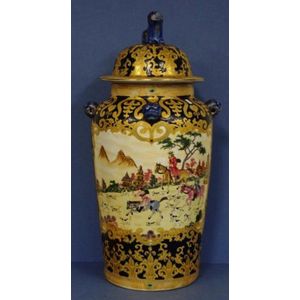Spode Buffalo Pattern Sugar Bowl with Lid
You must be a subscriber, and be logged in to view price and dealer details.
Subscribe Now to view actual auction price for this item
When you subscribe, you have the option of setting the currency in which to display prices to $Au, $US, $NZ or Stg.
- Willow Pattern - Although several potteries including Minton and Spode claim credit for design of the Willow pattern, the design is generally attributed to Thomas Turner of Caughley Porcelain Works in Shropshire, about 1780.
Whilst borrowing from the Chinese style, it was not a copy of a Chinese pattern.
The blue-and-white chinaware on which it appeared became immensely popular and the design was reproduced with variations by many English and European factories including Royal Worcester, Spode, Adams, Wedgwood, Davenport, Clews, Leeds and Swansea.
It was even copied in Asia, where it is still produced, with the wares being exported to Western countries.
The pattern portrays the garden of a rich mandarin whose young daughter elopes with his secretary. The lovers, overtaken on the bridge by her father, are transformed by the gods into birds and flutter beyond his reach. The scene with its willow tree usually covers the central part of a plate, dish, or bowl, with a border of butterflies, a fret, or other motif.
Traditional Willow pattern is in cobalt blue on white, though very occasionally other colours are used, such as purple or brown. The main part of the object contains the trees, houses, bridge, figures, and birds of the story and there is usually a fairly abstract pattern around the extremities. - Faux - A French word meaning "false", but when used in decorative arts, the intention is not to deceive, but to simulate the decorative effects of the more expensive material it is imitating. The term " faux bois" meaning "false wood" refers to a furniture item that has been decorated with a marked grain (woodgrain finish) to imitate a more expensive timber.
- A/f, as Inspected - The letters "A/F" or "as inspected" as part of a description is the cataloguer's shorthand for "all faults" or "as found", meaning the item has some type of damage or deficiency, it is of uncertain date or provenance, and/or that the seller takes no responsibility for the completeness of the item or the accuracy of the description.
- Gilding - Gilding is a method of ornamentation whereby a thin sheet of gold metal is applied to items made of wood, leather, ceramics, glass and silver for decorative purposes.
For furniture including mirrors, the sheet of gold is usually applied over a coating of gesso. Gesso is a mixture of plaster of Paris and gypsum mixed with water and then applied to the carved wooden frames of mirrors and picture frames as a base for applying the gold leaf. After numerous coats of gesso have been applied, allowed to dry and then sanded a coat of "bole", a usually red coloured mixture of clay and glue is brushed on and allowed to dry, after which the gold leaf is applied. Over time parts of the gilding will rub off so the base colour can be seen. In water gilding, this was generally a blue colour, while in oil gilding, the under layer was often yellow. In Victorian times, gilders frequently used red as a pigment beneath the gold leaf.
Metal was often gilded by a process known as fire gilding. Gold mixed with mercury was applied and heated, causing the mercury to evaporate, the long-term effect of which was to kill or disable the craftsman or woman from mercury poisoning. The pursuit of beauty has claimed many victims, not the least of which were the artists who made those pieces so highly sought after today.
This item has been included into following indexes:
- Copeland Spode (England), item types - dishes and bowls 162
- Copeland Spode (England), patterns
Visually similar items

Chinese blue & white lidded bowl. Figures & landscape decoration. Height 20 cm diameter 25 cm

Early Chinese blue and white lidded ceramic bowl, decorated with mythical animals. Double circle mark to base. Height 15 cm, diameter 14.5 cm

19th century Chinese export porcelain tureen, with cover, blue & white decorated with figural handles and lid, ex: R & V Tregaskis Oriental Art, 34.5 cm wide

Large Chinese ceramic lidded jar, Hunting scenes decoration in cartouche, on cobalt blue and gilt ground. Lid with temple dog finial. Character mark to base, height 72 cm
